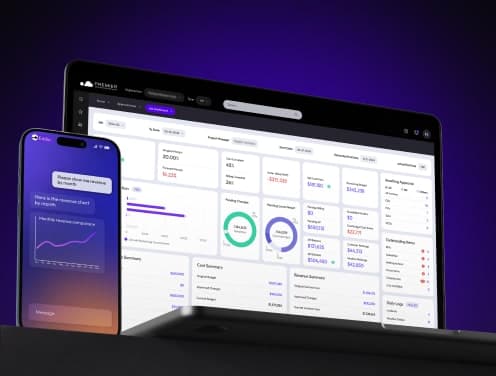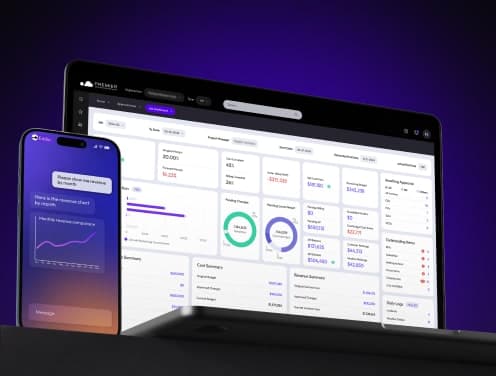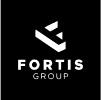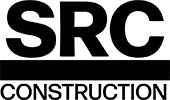
ROI in Construction: How to Measure and Improve Your Profitability
What pops off the top of my head when calculating construction ROI? Most construction professionals calculate ROI by dividing the net profit of a project by its total cost and expressing the result as a percentage. ROI in construction includes more than financial returns, it reflects each stakeholder's unique priorities and project values.
ROI calculation results in the construction industry serve as a vital decision-making tool. These results help you make investment choices, allocate resources effectively, review performance, and communicate with project stakeholders. Some companies place safety above everything else as their core measure of success. Other organizations prioritize environmental responsibility and define ROI through long-term effects rather than immediate profit.
Modern technology has simplified ROI tracking in construction management. Project management software lets you monitor projects with up-to-the-minute data, providing detailed resources to review return on investment. Cost tracking over time and analysis against budget goals ensure your investments deliver maximum value.
This piece will help you understand what ROI truly means in construction, how different stakeholders define it, and practical strategies to measure and boost your profitability across projects. You'll find that ROI isn't just about money, it creates lasting value throughout the entire construction process.
What ROI Means in the Construction Industry
ROI in construction goes way beyond a simple financial equation. Traditional ROI calculations divide net profit by total cost, expressed as a percentage. This basic formula barely scratches the surface of what return on investment really means in the building world.
Why ROI is more than just profit
The building industry presents a complex ROI landscape where success isn't measured by dollars alone. Financial outcomes matter but rarely capture the full value a construction project provides. Many construction professionals use a spectrum of metrics that reflect the industry's unique challenges and priorities.
Safety stands out as a vital ROI factor, especially in high-risk sectors like oil and gas. Companies don't define success by financial bottom lines but by prevented incidents and protected lives. This safety-first approach changes how they review their investments.
Environmental responsibility shapes how sustainability-focused organizations calculate ROI. These companies value keeping hazardous waste out of landfills or reducing emissions more than immediate financial gains. Real returns show up through long-term environmental effects.
Operational efficiency adds another significant ROI dimension. Every minute of downtime means substantial lost revenue for facilities like manufacturing plants or data centers. Teams review construction projects based on how well they minimize operational disruptions, not just cost savings.
Workforce stability often matters more than pure profit. Construction firms want their teams employed and involved in meaningful work. Project success extends to team growth, stability, and morale.
How construction ROI is different from other industries
Most sectors follow straightforward financial formulas for ROI calculations, but construction projects bring unique complexity. The industry connects diverse stakeholders, owners, general contractors, specialty contractors, architects, and subcontractors, each with their own priorities and definitions of success.
This stakeholder diversity requires construction ROI to work with multiple points of view at once. Owners might care about long-term efficiency while contractors focus on timelines and margins. Some measure ROI by hitting target profit margins; others look at uptime, safety metrics, or sustainability goals.
Construction ROI works harder than in many industries. Beyond checking profitability, it helps companies:
- Allocate resources effectively by identifying which projects deliver maximum returns
- Assess and alleviate project risks proactively
- Measure performance against industry standards
- Communicate value to diverse stakeholders
The timeline for evaluation is substantially different too. Many industries want immediate returns, but construction requires dissecting long-term value. This extended point of view includes factors like future maintenance costs, operational efficiencies, and building lifespan.
Construction ROI calculations must account for many variables that other industries don't face, regulatory compliance costs, weather delays, material price fluctuations, and labor availability. These factors create a multidimensional ROI landscape where success means balancing immediate financial needs against long-term value creation.
This complexity explains why construction firms now use specialized technology to track ROI metrics. U.S. construction spending reached USD 2.19 billion in January 2025, a 3% increase from the previous year. Understanding true ROI has never mattered more for industry profitability.
The Many Faces of ROI in Construction
ROI metrics in construction go way beyond profit margins. Construction professionals know that success takes many forms. Each form brings unique value to different stakeholders. Let's look at the key aspects that define how companies measure real returns in this industry.
Safety as a core ROI metric
Many construction companies see safety not just as a compliance requirement but as a key business metric that affects profits. American businesses lose over $90 billion every year due to workplace injuries in construction. This includes medical expenses, legal fees, and lost productivity, according to the Occupational Safety and Health Administration (OSHA).
Safety investments create returns in several ways:
- Lower insurance premiums and workers' compensation costs
- Reduced regulatory fines and legal expenses
- Fewer project delays from accidents
- Better employee retention and morale
Companies that take part in OSHA's Voluntary Protection Program save over $110 million each year. Their injury rates stay less than half the industry average. This shows how safety programs change from expenses into profit sources.
Construction firms need to track both direct costs like medical expenses and property damage, and indirect costs such as retraining and lost productivity to calculate safety ROI. OSHA offers calculators that help estimate these numbers accurately.
Sustainability and long-term value
The value of sustainability goes beyond short-term financial gains. It creates lasting financial, environmental, and social benefits. While 41% of executives aren't sure how to measure sustainability ROI, its advantages become clearer every day.
Green buildings show clear financial benefits. LEED-certified buildings use 25% less energy than regular buildings. This often makes up for the extra cost of getting green certification. Research from the World Green Building Council reveals sustainable buildings can cut operating costs by up to 37%.
Market data backs these benefits. ESG leaders earned 8% more returns than the broader U.S. market in 2021. Companies with high ESG scores also get 10% discounts on capital costs compared to lower-scoring ones.
Green initiatives might cost more upfront but create what experts call "submerged value." These hidden benefits are worth "4-10 times as much as visible value". This value shows up through better brand image, easier compliance, and stronger stakeholder trust.
Operational uptime and continuity
Delays in construction hurt more than schedules - they hit the bottom line. More than 75% of projects run late, with delays averaging 20%. A typical two-year project faces about 20 weeks of delays.
High-profit facilities like manufacturing plants or data centers lose substantial revenue with each minute of downtime. These operations judge construction projects mainly by how well they minimize disruptions.
Total Productive Maintenance (TPM) helps maximize ROI through smooth operations. TPM focuses on prevention, equipment performance, and waste reduction. This method keeps projects moving forward naturally. It cuts delays and risks while speeding up completion.
Employee satisfaction and workforce stability
Construction's workforce faces ongoing challenges with turnover rates above 21% - much higher than other industries. This turnover threatens productivity, safety, and profits.
Employee engagement makes a real difference in financial results. Gallup's research shows engaged employees work 17% more productively and take 41% fewer sick days. Companies with highly engaged teams outperform others by up to 202% and see 22% higher profits.
The National Center for Construction Education and Research points out that the industry needs about 240,000 new workers every year. Training and keeping skilled workers becomes crucial for ROI. A positive workplace creates real returns through:
- Better project efficiency and quality
- Lower hiring and training costs (replacing one construction worker costs 30-150% of their yearly pay)
- Fewer safety incidents (engaged teams have 70% fewer accidents)
- More innovation and problem-solving
Companies can calculate employee engagement ROI by comparing program costs with gains from lower turnover, higher productivity, and fewer accidents. This helps them understand the real value of investing in their people.
How Different Stakeholders Define ROI
Different stakeholders in a construction project rarely agree on what ROI means. Their viewpoints often create conflicting priorities that can derail projects without proper management. Here's how the players measure success in their own terms.
Owners: cost control and long-term efficiency
Owners and developers care about budgetary goals and operational efficiency over time. Their focus goes way beyond the reach and influence of the construction phase to include the asset's entire lifecycle.
Owners want minimal design changes, especially when late adjustments make costs skyrocket. This makes sense, they'll manage the building long after construction teams finish their work.
Owners look for economic value. A project should finish under budget or on schedule while meeting design requirements. The building needs to:
- Keep its social license to operate without upsetting stakeholders
- Control operating costs while meeting revenue targets
- Make acceptable profits throughout its lifetime
The long-term ROI matters a lot in infrastructure projects. Financial outcomes count because financing costs can match the original construction expense.
Contractors: timelines and margins
General contractors measure ROI through project timelines and budget targets. They succeed when phases stay on schedule and under budget.
Contractors' ROI depends on team efficiency, equipment use, and material costs. Their profits depend on knowing how to:
- Finish work ahead of schedule
- Skip costly rework or change orders
- Keep crews productive
- Make good deals during buyout
Speed affects contractors' profit margins directly. Quick completion lets them move to new jobs, which boosts yearly revenue while controlling overhead costs.
Architects: design quality and innovation
Architects look at ROI through design quality and innovation. They want to deliver lasting esthetic and functional value.
A well-designed building gives architects:
- Professional recognition and a better portfolio
- Sustainability awards and certifications
- Happy clients who refer new business
- New project opportunities
Studies show LEED-certified buildings sell for about 16% more than regular buildings. Green buildings with higher certification levels earn 3% more rent for each certification upgrade.
Why shared KPIs matter
These different priorities make shared KPIs a vital part of project startup. Owners usually get final say in decisions since "whoever holds the gold makes the rules". But ignoring other stakeholders' ROI needs creates conflict.
Setting KPIs early helps unite everyone around core metrics that work for all parties. Everyone agrees on:
- Safety measures and rules
- Budget expectations
- Schedule milestones and flexibility
- Quality standards and acceptance criteria
Project disasters often start with stakeholder disagreements that miss ROI targets and add surprise costs. Early consensus prevents resource fights, requirement mismatches, and schedule disputes that can disrupt projects.
This teamwork builds a foundation for quick decisions that speed up ROI payback. Construction management software makes shared work easier by connecting team members, clients, and stakeholders on one platform. These digital tools cut through bureaucracy and speed up data sharing, which boosts project ROI for everyone involved.
Using Technology to Track and Improve ROI
Construction companies have revolutionized their ROI tracking methods through technology. The old days of poring over endless spreadsheets and waiting for monthly reports are gone. Modern construction software gives you instant visibility into project performance, so you can spot opportunities and problems right away.
Custom dashboards and real-time data
Real-time dashboards act as command centers for construction projects. They combine scattered information from emails, spreadsheets, and handwritten notes into a live snapshot of project health. Teams managing thousands of moving parts now have a single source of truth that displays:
- Open RFIs and submittals
- Safety observations or incidents
- Crew hours and labor costs
- Daily logs and work progress
- Committed cost versus cost to complete
Real-time data gives teams a huge advantage. Problems used to surface during weekly or monthly cost meetings, usually after the damage was done. Now changes appear the moment they happen. Teams can catch errors, identify trends, and fix delays before they become major issues.
"A well-built dashboard should surface risks before they turn into missed deadlines or resource gaps," notes one industry expert. Project teams can now plan with purpose instead of reacting under pressure.
Configurable metrics for different teams
Construction needs vary widely, which makes configurable metrics crucial for ROI tracking. Modern construction software lets companies customize their tracking systems to match specific ROI metrics.
Project managers often focus on RFI turnaround times for quick issue resolution. Owners typically prioritize financial progress and budget adherence. This personalized approach helps stakeholders monitor what matters most to their success.
Your safety director can track incident rates while your finance team watches cost performance, all from the same data source with different views. This flexibility helps because stakeholders define ROI differently, as mentioned earlier.
Teams can create and share custom dashboards with specific project members to provide relevant information to different roles, users, or companies. Private dashboards offer extra project insight when needed.
Premier's role in ROI tracking
Premier Construction Software excels at delivering customized reporting and real-time ROI tracking. Their construction management software gives owners a centralized view of performance metrics across organizations.
The software's customizable dashboards show critical KPIs, financial health indicators, and project performance metrics that highlight opportunities and potential risks. Users get complete visibility into project costs and margins through automated budget tracking, change order management, and predictive analytics.
Clients typically see meaningful ROI within the first year through lower administrative costs, better cash flow, and improved project margins. Results include 75% reduction in invoice processing time, 90% faster bank reconciliation, and up to 20% improvement in project profit margins.
"Project managers can access detailed reports anytime, track outstanding subcontracts, and monitor accounts payable status," according to Premier. These features help keep projects on track and make smart decisions about cash flow, profits, and performance.
Ready to improve your ROI tracking? Book a demo with one of our product experts today to find out how Premier's solutions can boost your construction ROI management.
Early Planning and Risk Management
Early decisions in the construction process can make a huge difference to your ROI. Your bottom line depends on how well you manage risks and make decisions before breaking ground. Projects with teams that line up well in early stages deliver cost performance 6.5% below budget. On the flip side, projects that don't communicate business goals and team roles clearly end up spending 3.3% more and run 24.5% behind schedule.
Why early decisions matter most
The planning phase gives you the best chance to solve design problems, check risks, and adjust plans. One industry expert puts it straight: "The best time to make changes is before you've mobilized. Once you're in the field, any change has a magnified impact".
Here's a good example: changing a building's height during schematic design works fine because structural plans can adapt easily. The same change after construction starts leads to major rework, delays, and exploding costs, all of which cut into your project's ROI.
Project planning works like insurance, more investment upfront means better protection against surprises. Planning costs little but shapes the construction phase where 90% of cost and liability happen. You have the most power to change things when costs aren't locked in and different options remain open.
How to identify risks before mobilization
Construction ranks among the riskiest industries, showing one of the highest business failure rates across all economic sectors. These risk identification approaches can help protect your ROI early:
- Brainstorming sessions - Get stakeholders together to list potential risks in guided risk workshops
- Root cause analysis - Learn why problems happen instead of just spotting symptoms
- Assumptions analysis - Get into both obvious and hidden assumptions that might be wrong
- Document review - Look through project documents to find risks from flawed processes or limits
- Work Breakdown Structure review - Check risk identification against your WBS to find gaps
The Construction Industry Institute (CII) calls alignment "the condition when project participants work within acceptable tolerances to develop and meet a defined set of project objectives". Good alignment starts with front-end planning and helps shape behaviors, leading teams toward shared goals.
Aligning teams early for better outcomes
Teams work better with a shared vision when they line up early. Statistics show better, more predictable results when project owners and EPC partners talk openly.
CII's Alignment Thermometer tool helps solve team problems. This quick 10-question survey takes five minutes during team meetings and shows how well teams line up while pointing out where they disagree. Questions review key things like who represents stakeholders, how well leaders perform, and whether everyone agrees on priorities between cost, schedule, and quality.
Results tell you if your team works well and heads toward success, needs help with uncomfortable issues, or faces stress that could lead to failure. This tool becomes really useful as teams grow while moving from feasibility to concept to detailed scope phases.
Premier Construction Software makes early planning and risk management easier with dashboards you can customize to spot problems before they hurt your ROI. The software makes shared work possible and offers detailed project tracking, exactly what construction ROI needs.
Taking Calculated Risks for Long-Term ROI
Smart construction companies know that calculated risks often bring the greatest returns. The construction industry runs on thin margins, and strategic gambles can position your firm to get exceptional long-term ROI even without guaranteed immediate returns.
Entering new markets strategically
Your market expansion needs careful analysis before you make your move. Take Austin, where home prices increased by 40% since April 2020 because tech companies relocated and the population grew. Nashville shows a similar story with housing prices up 18% year-over-year and the country's second strongest job market.
The evaluation of new markets should look beyond current conditions to spot future growth indicators:
- Proximity to good schools, safety factors, and amenities like shopping and restaurants
- Job market strength and major employer presence
- Population growth trends and housing demand patterns
"Pay attention to the market and look for areas to tap into new growth," advises one industry expert. The research of future development plans becomes crucial for any community you think over - neighborhoods without room for growth limit your long-term ROI potential.
Balancing short-term losses with future gains
Lower original margins can serve as a strategic investment in market expansion. General contractors might bid aggressively on projects in new regions or switch to unfamiliar project types like moving from retail centers to multifamily housing. This strategy helps you establish a foothold in new territory where you learn the local landscape and build credibility with clients.
One construction leader puts it this way: "General contractors are gamblers by nature. We're always weighing the odds - is the juice worth the squeeze? Whether it's entering a new market or taking on a complex project type, we accept the risk because the potential reward can be worth it".
This measured approach to resource allocation might include leasing specialized equipment for remote projects instead of buying it outright. You reduce the risk of expensive assets sitting idle between jobs by minimizing capital investment.
Building relationships through adaptability
Strategic risk-taking helps foster strong relationships with clients and subcontractors beyond financial benefits. Your company becomes a preferred partner for challenging projects by building a reputation for adaptability and problem-solving.
A workplace that prioritizes risk awareness proves vital to successful strategic risk management. Your employees at all levels should get knowledge and skills to identify, understand and respond to risks through regular training sessions and workshops.
Communication plays a key role too. Your workers should feel free to speak up about potential risks without fear of repercussions. This creates a culture where teams spot problems early. Executives who actively support and model risk-aware behaviors - participating in risk assessments, following compliance protocols, and openly discussing risk decisions - set the tone for the entire organization.
Premier Construction Software gives you the tools to manage these calculated risks. The detailed tracking tools monitor project performance against established metrics. This gives you confidence to pursue strategic opportunities while you retain control of finances.
Protecting Margins and Building Repeat Business
Your construction business's ROI depends on protecting profit margins and building strong client relationships. Success comes from tracking costs carefully, getting good deals from suppliers, and keeping your clients happy enough to give you repeat business.
Job costing and cost reporting
Job costing breaks down all expenses for each project. You can track every dollar spent on labor, materials, equipment, and subcontractors. This detailed view helps you spot where money slips away from your projects.
Most construction companies just use general ledgers to track finances. This method fails to give project-specific details. Good job costing creates a current audit trail that catches extra expenses before they cut into your profits.
Cost reporting works with job costing to document and analyze your project finances. You get up-to-the-minute data about current status and predicted outcomes. To name just one example, phase-based job costing looks at each project phase as a separate job. This helps you catch cost overruns while work continues.
Negotiating during buyout phase
The buyout process gives you a great chance to protect your margins through smart negotiation. Good buyout management helps you get competitive bids from subcontractors and suppliers, which affects your profits directly.
Smart negotiation at this stage can save you lots of money. Here's an example: if you set aside $125,000 for window caulking but find a subcontractor who bids $100,000, you've added $25,000 to your profits.
Think over long-term value when picking partners. Paying a bit more for a reliable subcontractor often saves money over time. You'll deal with fewer change orders and get better quality work.
Client satisfaction as a growth strategy
Repeat business drives construction profitability. The industry's customer retention rate stands at 80%, so keeping clients happy affects your long-term ROI.
Happy clients start with clear communication throughout the project. Set realistic goals and schedules early to manage expectations. Deliver quality work on time, keep clients updated, and fix problems quickly.
Little things make a difference. Quick follow-up calls after finishing a project show clients you care about their satisfaction. Happy customers promote your business and bring referrals, which creates steady growth for your company.
Premier’s Approach to ROI in Construction
Premier’s construction ERP software helps solve the ROI challenges covered in this piece. The construction accounting solution addresses both immediate money concerns and ways to create lasting value that builders deal with every day.
How Premier helps track financial and non-financial ROI
Premier merges financial monitoring with other key metrics like safety incidents and quality checks. The project dashboards show vital indicators that match your company's ROI goals. You can watch your overall financial health and specific project results at the same time. This gives you both big-picture and detailed views of your construction business.
Up-to-the-minute data analysis and automation
Premier does away with multiple spreadsheets through automated data collection from your operations. The live dashboards highlight:
- Project progress compared to budget
- Worker productivity numbers
- Material usage stats
- Equipment use efficiency
These insights help catch problems before they hurt your profits. You can plan ahead instead of just reacting to issues.
Better teamwork between groups
Premier closes the gap between field crews and office teams. The construction project management software serves as a central hub that brings together estimators, project managers, accountants, and leaders. Everyone stays focused on common goals.
Companies that use Premier process invoices faster, handle bank statements better, and make more money. As projects become more complex, Premier's tools grow with your changing needs to track ROI. This helps you make better business decisions with confidence.
Conclusion
Construction ROI extends way beyond simple profit calculations. This piece shows how different stakeholders measure success through various perspectives, from safety metrics and sustainability goals to operational uptime and workforce stability. Maximizing construction profitability depends on arranging these different points of view.
Technology plays a significant role in tracking ROI. Modern software tools provide up-to-the-minute data analysis of project performance and help quickly identify problems and opportunities. You can spot trends immediately instead of waiting for monthly reports and make adjustments before problems affect your bottom line.
Strong team coordination during planning phases delivers cost performance 6.5% below budget, making early planning the most powerful ROI driver. This approach helps identify risks, unite teams around shared goals, and make decisions when changes still cost very little.
Smart risk-taking often produces the greatest returns. Moving into growing markets like Austin or Nashville might require short-term margin sacrifices but positions your company to stimulate substantial long-term growth.
Job costing and strategic negotiation during the buyout phase protect your profit margins directly. Client satisfaction creates repeat business and referrals that lower your customer acquisition costs significantly.
Premier Construction Software enhances these approaches with tools that connect teams, automate reporting, and display both financial and non-financial metrics in customizable dashboards. Companies need systems that adapt to their changing ROI tracking needs as construction projects become more complex.
Note that construction ROI reflects your company's specific priorities. Financial returns matter, but true success comes from creating value that arranges with your strategic goals, whether that's safety excellence, environmental leadership, operational efficiency, or workforce stability. Taking a comprehensive view of ROI and implementing these strategies will help build a construction business that runs on success both today and tomorrow.
Key Takeaways
Construction ROI extends far beyond simple profit calculations to encompass safety, sustainability, operational efficiency, and workforce stability metrics that drive long-term value.
• Early planning delivers 6.5% better cost performance - Strong team alignment during planning phases prevents costly changes and protects profit margins • Different stakeholders require different ROI metrics - Owners focus on long-term efficiency, contractors on timelines, architects on design quality • Real-time technology transforms ROI tracking - Modern dashboards identify issues before they impact bottom lines, shifting from reactive to proactive management • Strategic risk-taking enables market expansion - Accepting short-term margin sacrifices in growing markets positions companies for substantial long-term returns • Client satisfaction drives sustainable growth - With 80% industry retention rates, repeat business and referrals dramatically lower customer acquisition costs
The construction industry's complexity demands a holistic approach to ROI that balances immediate financial returns with long-term strategic value creation across all stakeholder priorities.
FAQs
Q1. How is ROI calculated in construction projects? ROI in construction is calculated by dividing the net profit by the total investment cost and multiplying by 100. However, it's important to note that ROI in construction goes beyond just financial metrics and can include factors like safety, sustainability, and operational efficiency.
Q2. What factors contribute to a low ROI in construction? Low ROI in construction can result from poor quality workmanship leading to defects and rework, ineffective project planning, unexpected delays, cost overruns, and inadequate risk management. Failing to consider long-term value and focusing solely on short-term profits can also negatively impact ROI.
Q3. How can technology improve ROI tracking in construction? Modern construction management software provides real-time dashboards and customizable metrics that allow for immediate visibility into project performance. This enables quick identification of issues and opportunities, shifting management from reactive to proactive and ultimately improving ROI.
Q4. Why is early planning crucial for maximizing construction ROI? Early planning is vital because it allows for risk identification, team alignment, and critical decision-making when changes are least costly. Projects with strong team alignment during early phases typically deliver cost performance 6.5% below budget, directly impacting ROI.
Q5. How does client satisfaction impact long-term ROI in construction? Client satisfaction is crucial for long-term ROI as it leads to repeat business and referrals. With an industry average customer retention rate of 80%, maintaining client satisfaction through clear communication, quality workmanship, and proactive problem-solving can significantly reduce customer acquisition costs and drive sustainable growth.





















